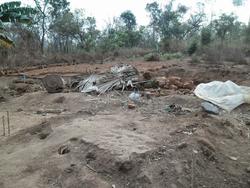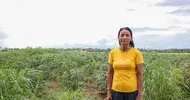
The forcibly displaced farmers of Kamsisomwa, Tanzania have launched a crowdfunding campaign to pay for legal support.
Jane Goodall Institute’s REDD project in Tanzania: A totalitarian approach to conservation that led to increased inequity, undermining of democracy, and violent evictions
In March 2009, Norway launched its REDD programme in Tanzania. This was a “nested approach”, that was to include developing a national REDD strategy, national forest monitoring, and local pilot projects. About one-third of Norway’s US$90 million went to eight NGOs. One of these NGOs was the Jane Goodall Institute.
In 2014, Emma Jane Lord, now a PhD candidate at the University of Bergen, carried out five months of months of fieldwork looking into the Jane Goodall Institute’s US$2.76 million REDD project in the Masito Ugalla Ecosystem. She carried out 66 in-depth interviews with peasants, pastoralists, local politicians, implementers of REDD, NGO staff, and academics.
Lord’s research is written up as a chapter in the new book, “Global Forest Governance and Climate Change” edited by Emmanuel O. Nuesiri.
Her findings are shocking. Lord writes of violent evictions that took place in August 2012 in two villages in the project area.
Violent evictions
On 14 August 2012 an armed group of District Natural Resource Officers, Park Rangers and police entered Kasakati, a settlement of about 30 households near Lake Tanganyika. They were guided by men from a neighbouring village who were working as Voluntary Forest Monitors for the Jane Goodall Institute.
The armed men threatened and beat villagers, destroyed their crops, and seized valuable possessions such as chickens and tools.
“Men and women were severely beaten using sticks and a rubber inner tube,” Lord writes. Some villagers were forced to eat soap. A ten-year old boy was kicked so badly that he later died.
They ordered villagers, at gunpoint, to burn down their homes and harvest stores. The leader of the evicted village told Lord,
I was beaten there with my wife and my children also were beaten. Thereafter, they cut all the bananas, all the palm oils, they left nothing there. There inside, there were like ten bags of this rice paddy, they burnt everything, they burnt the maize, they burnt the house, then they had nothing left.
Nine villagers were arrested. They were severely beaten, and imprisoned without medication. “Some sustained lasting physical deformation,” Lord writes. The nine villagers were subsequently taken to court. After lengthy proceedings the prosecution was unable to provide any evidence and the case was dismissed in 2013.
On 15 August 2012, another group of Forest Monitors from a different neighbouring village guided armed authorities to Mwasha, a settlement of 40 households. Again, the authorities seized possessions, destroyed crops, palm and fruit trees. They burned down homes and harvest stores. Chickens were burned inside their coups. The men living in the settlement were badly beaten. Some of them were crippled.
Jane Goodall Institute: Seeing REDD
The English primatologist Jane Goodall founded the Jane Goodall Institute Initially in 1977. Goodall first visited the Gombe National Park in 1960, and is famous for her research into social and family interactions of wild chimpanzees.
The Jane Goodall Institute initially focussed on chimpanzee research and conservation in the Gombe National Park. From the 1990s, the Jane Goodall Institute started working with communities to reduce deforestation around the National Park.
In a talk she gave to World Bank staff in 2011, Goodall explained the change in focus:
“It was in early 1990 that I flew over the Gombe National Park – it’s tiny, it’s only 30 square miles, but we flew over all the land around it and it was absolutely horrifying to me to see that, yes, I knew there was deforestation outside the park but I had not realized it was total deforestation.”
In 2011, Benoît Bosquet, then the coordinator of the World Bank’s Forest Carbon Partnership Facility, wrote a post on the World Bank’s website about Jane Goodall and REDD.
“The social dimension of REDD is critical”, Bosquet wrote. “REDD is not designed to solve poverty, but unless it contributes to poverty reduction and sustainable development, it will not succeed.”
Bosquet reported Goodall as saying that,
“The people have got a better standard of life and there is an enormous desire on their part to save the forests, and of course they are safeguarding the future of their own people but they are also now interested in the chimpanzees and the other animals living there. They are excited at the thought we might be able to develop a leafy corridor of trees leading down to this other huge area where we are working in the south.”
Compare this to Lord’s analysis of the situation in the Jane Goodall Institute’s REDD project area in 2014:
"[C]onservation objectives were already authoritarian and REDD+ has heightened this trend, contradicting livelihood objectives of REDD+."
In fact, Lord notes, the first evictions from Kasakati were in 2004. In the competitive bidding process for REDD in Tanzania, the history of evictions from project villages was completely invisible. With the REDD project, Lord writes, “The infusion of capital available increased the scale and severity of the conflicts compared with previous projects.”
In 2007, the Jane Goodall Institute started its Masito Ugalla Ecosystem project, aimed at protecting about 70,000 hectares of forested landscape south of the Gombe National Park.
Two years later, the Jane Goodall Institute received US$2.76 million from the Norwegian Embassy in Tanzania to implement REDD in the Masito Ugalla Ecosystem Pilot Area, together with the Woods Hole Research Center, Sokoine University of Agriculture, the University of Dar es Salaam and the Kigoma District Council.
Lord writes that,
"The strategy of the NGO, using formal boundaries for forest protection align with the approach of REDD+ to protect a clearly defined and measurable area. Both take a totalitarian approach to forest protection, for their respective goals of undisturbed chimpanzee habitat or quantifiable units of carbon storage."
Money for consulting firms
The majority of Norway’s REDD funding for the Jane Goodall Institute REDD project went to consulting firms. Lord notes that while international scientific experts, national and regional developed elites have benefited this came at the expense of forest livelihoods.
Lord writes that,
"The majority of project funding went into consultancy fees for commissioned reports and workshop training sessions, with only 6.4% of US $2.8 million budget used for infrastructure payments resulting in the construction of five schools and two village offices."
International policymakers assume that “those actors receiving compensation for REDD+ and those bearing the costs are one and the same”, Lord writes. But her research uncovered the fact that this is a “vastly over-simplistic economic rationality and “does not hold in a field context”.
Lord lists the tasks that consultants were hired to carry out:
- qualify carbon reporting at local and national scales,
- predict the effects of fire on carbon accounting,
- conduct a baseline assessment,
- review the NGO’s previous project literature,
- consult key informants,
- report on strengthened organisations and cumulative behaviour change,
- build the capacity of selected stakeholders, and
- develop and conduct around 100 days of training workshops.
Lord writes of a “carbonization” of forest governance, and notes concerns that a “strong focus on performance-based payments … would simplify the complex aspects involved in implementing co-benefits on the ground”.
The dynamic boundary conflicts that ultimately led to the violent evictions, “remain illegible to carbon’s global gaze”, Lord writes.
Free Prior and Informed Consent: “A sophisticated box ticking exercise”
REDD in Tanzania builds on the governance arrangements developed through Participatory Forest Management, using village-level political structures.
A CIFOR report about the Jane Goodall Insitute’s REDD project states that, “JGI began disseminating information and carrying out the FPIC process at the beginning of 2010.”
Lord describes the process as a “two-week consultancy commission”, that “amounted to little more than a sophisticated box ticking exercise”.
Elite capture and parallel governance
The project created an “incentive fund” of US$200,000 to fund village-level infrastructure (the five schools and two village offices mentioned above) and to set up an inter-village Community Based Organisation to provide conservation education and forest protection.
Five members from each village were selected from the Village Environmental sub-Committees, created under previous conservation projects. Lord comments that, “This could be regarded as a form of elite capture because they selected the wealthier members of the village.”
Conservation education consisted of training on governance and REDD for the members of the Community Based Organisation, which they then explained to the rest of the village. The project also offered training on replacing charcoal making and other forest degrading activities with beekeeping, poultry management, and agricultural activities.
Villagers had to buy beehives themselves, which they couldn’t afford. Even successful beekeeping groups reported only low returns.
Forest protection involved forest surveillance and patrols. The Community Based Organisation set up about five local informants in each village, who reported on forest activities. There were seven Voluntary Forest Monitors in each village, three under the REDD programme and four under the conservation programme. They received military training but were not authorised to carry firearms. The Forest Monitors recorded animal sightings and human activity in the Masito forest, using GPS to record the information.
Joint patrols took place every six months. For these patrols, the Forest Monitors were joined by District Natural Resource Officers, Park Rangers, and police. Lord writes that, “This parallel authority undermined the political power of the democratically elected local chairman to represent the interests of the villagers and respond to their demands.”
“In effect,” Lord writes, “the CBO was a parallel institution to the village government because they responded to the international NGO [Jane Goodall Institute]. The incentive structure provided by REDD+ exaggerated this power discrepancy, through the provision of capital.”
The REDD project’s decisions were “authoritarian”
A 2008 participatory Land Use Planning process was supposed to have reached consensus on village and forest boundaries. But the REDD project took a different approach. The Community Based Organisation secretary was present when the REDD project boundaries were demarcated. He explained the process to Lord as follows,
what I saw, there were the maps of a long time ago from the district council. Because the maps were there and the maps use longitudinal and latitudinal. So we were just going there and using GPS, that means me, [REDD+ Project team member] was experienced using the GPS and the GPS were helping us in locating where the border was supposed to be, according to the maps that were already drawn.
Farmers in the area did not accept this REDD boundary. But the Forest Monitors believed their version of the boundary to be correct. Lord notes that,
This clearly indicates the power relations between the NGO, CBO and FM determining public domain in this land and how these relations are being contested. The use of technology heightens these inequities. Only experts have access and the knowledge to define the coordinates. As the REDD+ project team are only present within the study location for a very limited time, their decisions are essentially authoritarian.
The Jane Goodall Institute had hoped to finance the project from sales of carbon credits. The contract between the Norwegian Ministry of Foreign Affairs and the Jane Goodall Institute explains that,
It is estimated that greenhouse gas emissions from deforestation and forest degradation will be reduced by an average annual amount of 55,000 tCO”eq, and that the forest management community-based organization will generate an annual net income from the sale of carbon credits totalling $400,000.
No carbon credits were sold and money from the Norwegian Embassy in Tanzania to the Jane Goodall Institute’s REDD project dried up in 2013.












